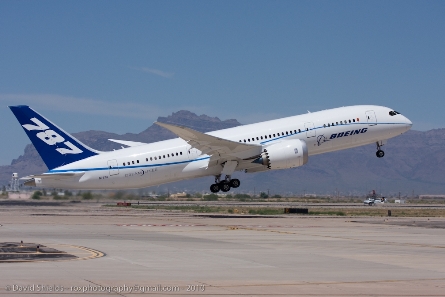As the 787 closes in on a November or December first delivery to All Nippon Airways followed by a January entry into service, Boeing is pressing to prepare the first pilots to fly its new jetliner.
The company recently completed two of the three stages toward formally validating the 787's handling and 777 training commonality with global regulatory authorities.
The first stage, T-1, a paper-based systems comparison, was followed by the more rigorous T-2 phase. T-2 took six 777 line pilots, three representing the US Federal Aviation Administration, one from EASA, one from the Japanese Civil Aviation Bureau and another from Transport Canada. They were put in the left seat of the 787 to prove the handling qualities are similar to that of a 777.
With a Boeing test pilot in the right seat, 777 pilots conducted various manoeuvres including touch-and-go landings, single engine cutouts on takeoff, approaches, as well as missed approaches and approaches with a full stop landing.
 |
|---|
© Boeing |
Mike Carriker, chief 787 project pilot, says pilots report the aircraft flies "like a 777. And while some said it was either a bit higher, low or about the same on flare forces, they all landed it on the right speeds, on the numbers and on the centerline".
The final phase, T-3, will validate the training course through a final FAA check ride and has already seen more than 100 Boeing staff participate internally, says Carriker.
Boeing aims to transition 777 pilots in five days to the 787, eight days for 757/767 pilots and 11 days from the 737.
Meanwhile, Boeing has restarted 787 final assembly following a 24-manufacturing-day hold on deliveries of aircraft structure to final assembly.
Deliveries to the company's Everett, Washington, facility resumed on 6 June with the arrival of the aft fuselage section for Airplane 23, destined for Japan Airlines, as well as the horizontal stabiliser for Airplane 25, the first 787 for Air India.
Boeing halted deliveries on 27 April to allow its supply chain to catch up following part shortages and design changes, including a modification and re-work of aluminium shear ties in the unpressurised parts of the aft fuselage.
Before deliveries were halted in April, Boeing was taking delivery to final assembly of roughly two new airframes per month. That pace is expected to continue with the arrival of the latest sections. In the interim, the airframer continued work on the 16 production aircraft already in Everett.
Programme sources say the airframer hopes to build three 787s per month by September and just over three and a half by the end of the first quarter of 2011.
On the flight line, ZA005, the first GEnx-1B powered 787 is approaching its first flight, running mini-gauntlet closed-loop testing on 8 and 9 June. While Boeing declines to target a specific date for the aircraft's first flight, programme sources say the flight could happen as early as 16 June.
Source: Flight International
















